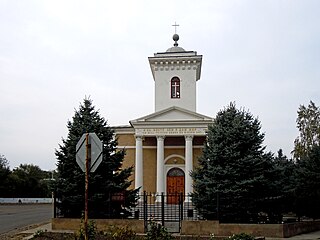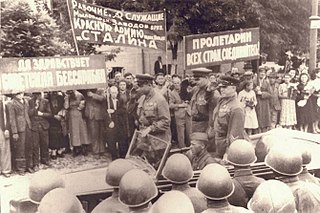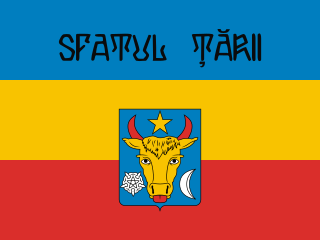The history of Moldova can be traced to the 1350s, when the Principality of Moldavia, the medieval precursor of modern Moldova and Romania, was founded. The principality was a vassal of the Ottoman Empire from 1538 until the 19th century. In 1812, following one of several Russian–Turkish wars, the eastern half of the principality, Bessarabia, was annexed by the Russian Empire. In 1918, Bessarabia briefly became independent as the Moldavian Democratic Republic and, following the decision of the Parliament, united with Romania. During the Second World War it was occupied by the Soviet Union which reclaimed it from Romania. It joined the Union as the Moldavian ASSR, until the dissolution of the USSR. In 1991 the country declared independence as the Republic of Moldova.

Bessarabia is a historical region in Eastern Europe, bounded by the Dniester river on the east and the Prut river on the west. About two thirds of Bessarabia lies within modern-day Moldova, with the Budjak region covering the southern coastal region and part of the Ukrainian Chernivtsi Oblast covering a small area in the north.

The Moldavian Democratic Republic, also known as the Moldavian Republic or Moldavian People's Republic, was a state proclaimed on 15 December [O.S. 2 December] 1917 by the Sfatul Țării of Bessarabia, elected in October–November 1917 following the February Revolution and the start of the disintegration of the Russian Empire.

The Moldavian Autonomous Soviet Socialist Republic, shortened to Moldavian ASSR, was an autonomous republic of the Ukrainian SSR between 12 October 1924 and 2 August 1940, encompassing the modern territory of Transnistria as well as much of the present-day Podilsk Raion of Ukraine. It was an artificial political creation inspired by the Bolshevik nationalities policy in the context of the loss of larger Bessarabia to Romania in April 1918. In such a manner, the Bolshevik leadership tried to radicalize pro-Soviet feelings in Bessarabia with the goal of setting up favorable conditions for the creation of a geopolitical "place d'armes" (bridgehead), in an attempt to execute a breakthrough in the direction of the Balkans by projecting influence upon Romanian Bessarabia, which would eventually be occupied and annexed in 1940 after the signing of the Molotov–Ribbentrop Pact.

Sarata is a rural settlement in Bilhorod-Dnistrovskyi Raion, Odesa Oblast (region) of south-western Ukraine. It is a part of the Bessarabian historic district of Budjak. Sarata hosts the administration of Sarata settlement hromada, one of the hromadas of Ukraine. Population: 4,159.

The Khotyn Uprising was a Ukrainian-led insurrection in the far-northern tip of Bessarabia region, nestled between Bukovina and Podolia. It occurred on January 7–February 1, 1919, less than a year after Bessarabia's annexation by the Romanian Kingdom. The city it was centered on is now known as Khotyn (Хотин), and is located in Chernivtsi Oblast, Ukraine; in 1919, it was the capital of Hotin County, on the unofficial border between Romania and the Ukrainian People's Republic (UNR). The revolt was carried out by armed locals, mainly Ukrainian peasants, assisted by Cossack deserters from the Ukrainian People's Army and groups of Moldovans, with some support from local Bolsheviks and White Russians. It forms part of the Ukrainian War of Independence, though whether or not the UNR covertly supported it, beyond formally reneging it, is a matter of dispute. The role of Bolsheviks, which has been traditionally highlighted in Romanian and Soviet historiography alike, is similarly debated. The Khotyn Uprising is therefore ambiguously linked to the Russian Civil War and the Ukrainian–Soviet War.

The Bessarabian Soviet Socialist Republic or Bessarabian SSR was a revolutionary committee created under the patronage of Soviet Russia to establish a Soviet republic within Bessarabia. The only Bessarabian territory under the committee's control was the town of Bender during the uprising of 27−28 May 1919. While the government was disbanded later in 1919, the idea was revived during the Tatarbunary Uprising, when another committee held control over some villages in southern Bessarabia for a few days in September 1924.

The Bessarabian Bulgarians are a Bulgarian minority group of the historical region of Bessarabia, inhabiting parts of present-day Ukraine and Moldova.

The Soviet occupation of Bessarabia and Northern Bukovina took place from 28 June to 3 July 1940, as a result of an ultimatum by the Soviet Union to Romania on 26 June 1940, that threatened the use of force. Those regions, with a total area of 50,762 km2 (19,599 sq mi) and a population of 3,776,309 inhabitants, were incorporated into the Soviet Union. On October 26, 1940, six Romanian islands on the Chilia branch of the Danube, with an area of 23.75 km2 (9.17 sq mi), were also occupied by the Soviet Army.

The Tatarbunary Uprising was a Bolshevik-inspired and Soviet-backed peasant revolt that took place on 15–18 September 1924, in and around the town of Tatarbunary in Budjak (Bessarabia), then part of Romania, now part of Odesa Oblast, Ukraine. It was led by a pro-Soviet revolutionary committee which called for the creation of a "Moldavian Soviet Republic" and an end to "Romanian occupation".

Sfatul Țării was a council that united political, public, cultural, and professional organizations in the greater part of the territory of the Governorate of Bessarabia in the disintegrating Russian Empire, which was transformed into a legislative body and proclaimed the Moldavian Democratic Republic as part of the Russian Federative Republic in December 1917, and then union with Romania in April [O.S. March] 1918.

Bălți is the second largest city in Moldova. It is located in the northern part of the country, within the historical region of Bessarabia, with which the city's own history is closely intertwined.
The union of Bessarabia with Romania was proclaimed on April 9 [O.S. March 27] 1918 by Sfatul Țării, the legislative body of the Moldavian Democratic Republic. This state had the same borders of the region of Bessarabia, which was annexed by the Russian Empire following the Treaty of Bucharest of 1812 and organized first as an Oblast and later as a Governorate. Under Russian rule, many of the native Tatars were expelled from parts of Bessarabia and replaced with Moldavians, Wallachians, Bulgarians, Ukrainians, Greeks, Russians, Lipovans, Cossacks, Gagauzes and other peoples, although colonization was not limited to formerly Tatar-inhabited lands. Russia also tried to integrate the region by imposing the Russian language in administration and restricting education in other languages.

Gherman Vasile Pântea was a Bessarabian-born soldier, civil servant and political figure, active in the Russian Empire and Romania. As an officer of the Imperial Russian Army during most of World War I, he helped organize the committees of Bessarabian soldiers, oscillating between loyalty to the Russian Provisional Government and the cause of Bessarabian emancipation. Pântea was subsequently Military Director of the Moldavian Democratic Republic, answering to President Ion Inculeț. He personally created a Bessarabian defense force, tasked with combating Bolshevik subversion and Russian intimidation, but also braced for defeat after the October Revolution.

Vasile Gheorghe Cijevschi was a Bessarabian and Romanian politician, administrator and writer. Originally a career officer and Orientalist in service to the Russian Empire, he was dispatched to the Far East, in Vladivostok and Khabarovsk, seeing action in the Russo-Japanese War. He was wounded and shielded from active duty, but returned with the start of World War I, managing to survive the Battle of Tannenberg. By the time of the February Revolution, he was a civil servant in Bessarabia, and an affiliate of the Octobrist Party.
Vladimir Vladimirovich Tsyganko was a Bessarabian, and later Soviet, politician. The son of a distinguished architect, and himself an engineer by vocation, Tsyganko entered politics shortly before the proclamation of a Moldavian Democratic Republic, when he earned a seat in the republican legislature. He sided with the parliamentary Peasants' Faction, which supported left-wing ideals and pushed for land reform, being generally, and radically, opposed to the more right-wing Moldavian Bloc. Tsyganko was skeptical of the Bloc's plan to unite Bessarabia with Romania, although he possibly supported a federation. His uncompromising stance divided his Faction and led the Romanian Kingdom's authorities to identify him as a major obstruction to the unionist cause.

Anatolie Popa was a Bessarabian-born military commander active during World War I and the Russian Revolution and Civil War, one of the organisers of the Moldavian armed resistance against the advancing Romanian troops in January 1918.

The Romanian military intervention in Bessarabia took place between 19 January and 8 March 1918, as part of the broader Allied intervention in the Russian Civil War. It pitted the Kingdom of Romania, Russian Republic, Ukrainian People's Republic and anti-Bolshevik factions of the Moldavian Democratic Republic on one side, against the Bolshevik controlled Rumcherod and Odesa Soviet Republic, as well as pro-Bolshevik factions within the Moldavian DR. The intervention began when the Romanian army and its allies crossed into Bessarabia and launched an attack on Chișinău and Ungheni, capturing the latter.
The Moldovan resistance during World War II opposed Axis-aligned Romania and Nazi Germany, as part of the larger Soviet partisan movement. The Moldavian Soviet Socialist Republic (MSSR), presently Moldova, had been created in August 1940 after a Soviet annexation, and liberated by Romania during Operation Barbarossa. Moldovan resistance straddled across a new administrative border: in 1941–1944, Bessarabia was reincorporated within Romania as a semi-autonomous governorate, while areas across the Dnister were administered into a separate Transnistria Governorate. Shortly after the German–Romanian invasion of June–July 1941, the Communist Party of Moldavia (PCM) ordered the creation of a partisan network. The order was largely ineffective in creating an organized movement due to the rapid disintegration of Soviet territorial structures in Bessarabia. Some early organizers opted to abandon their posts, and Soviet attempts to infiltrate experienced partisans across the front line were often annihilated by the Special Intelligence Service. Nevertheless, partisan formations were still able to stage large-scale attacks on the Romanian infrastructure, at Bender and elsewhere. While Romanian documents identified categories of locals influenced by communist ideas as a passive component of the resistance, various modern commentators point to the overall unpopularity of communism in Bessarabia as accounting for the movement's marginality.

The uprising of Nykyfor Hryhoriv was an armed protest against the Bolshevik rule in Ukraine in May 1919, which covered the area between Mykolaiv and Kherson, Katerynoslav, Cherkasy, Kremenchuk and Kryvyi Rih. Its leader was otaman Nykyfor Hryhoriv, who gathered around him guerrilla troops of peasants rebelling against food requisitions and repression led by the Cheka.
















